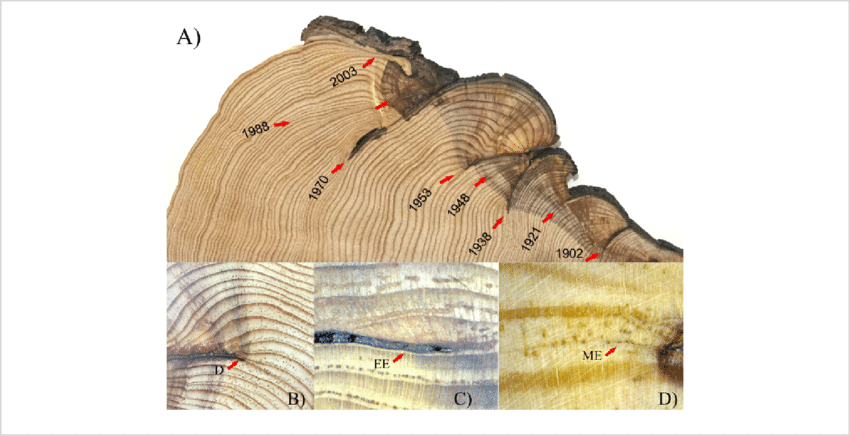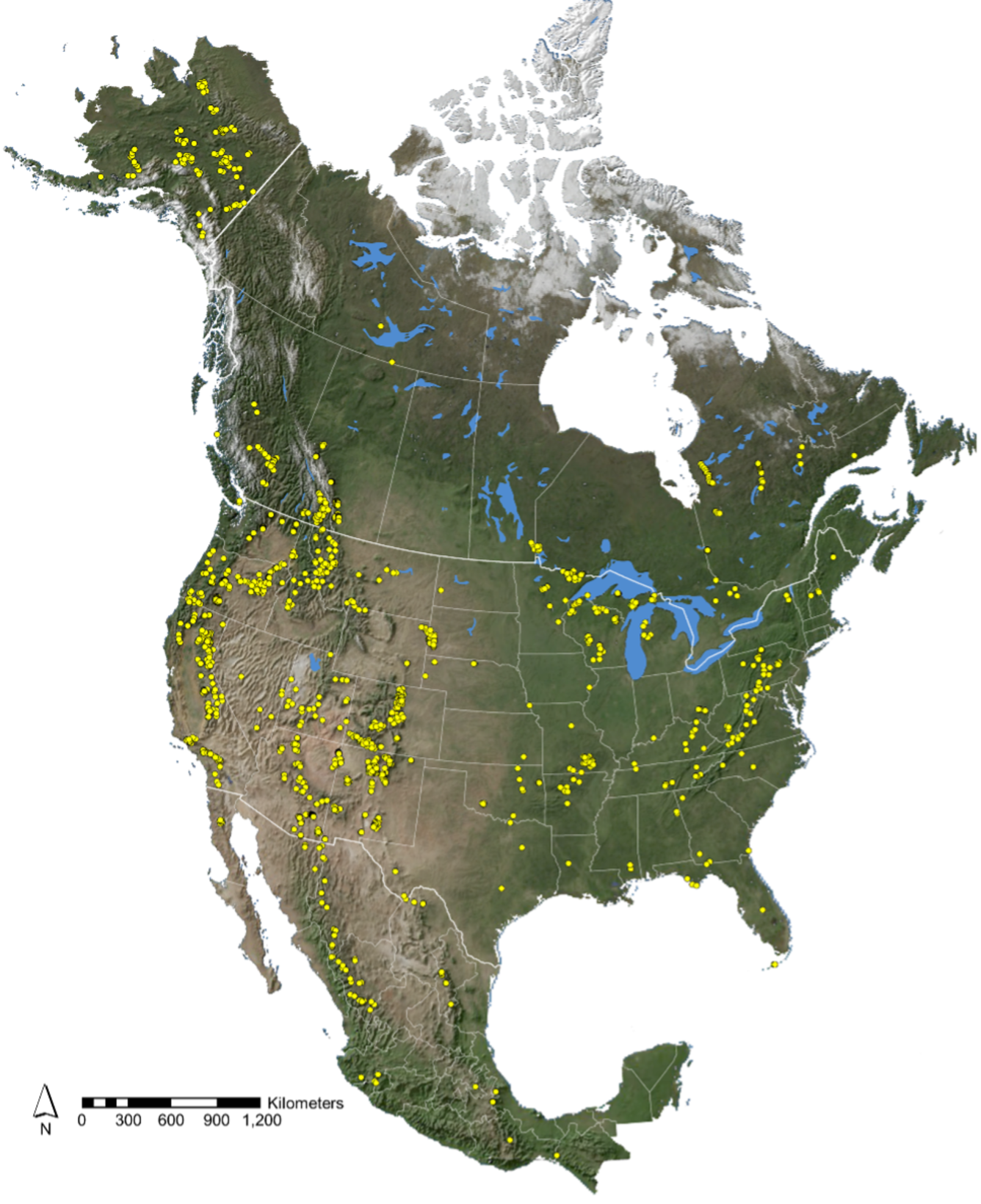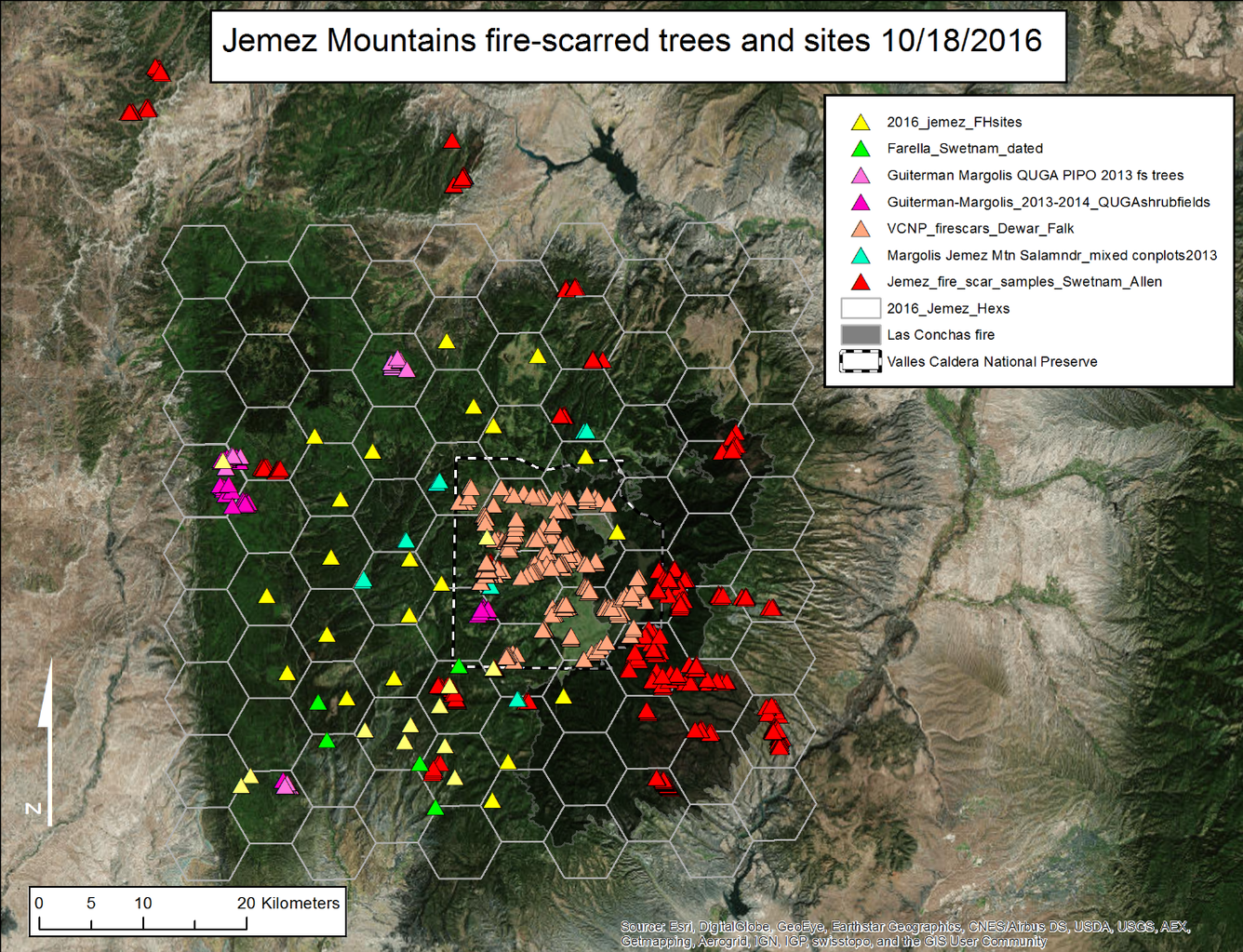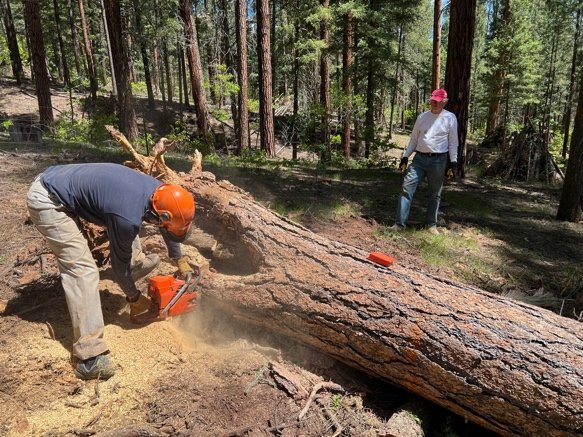Hello, Fireshed readers!
My name is Dayl Velasco. I’m a project coordinator at the Forest Stewards Guild and the newest contributor to the Fireshed blog. Much of my work revolves around fire, from assisting with prescribed burns to collecting data on forest health pre- and post-thinning and burning to measure landscape resilience, and I’m excited to continue working in this realm as I help to coordinate this publication. Nice to meet you!
Today’s Wildfire Wednesday focuses on how scientists use the life history of fire scarred trees that is recorded in their rings (seen in a crosscut of wood) to understand historic fire regimes and date specific fire events. You’ll be introduced to the North American Tree-Ring Fire-Scar Network, which was compiled in 2022 and contains over 37,000 sampled trees across North America. You’ll learn about work closer to home with a brief overview of New Mexico’s own Jemez Mountains Tree-Ring Lab and the research they do and the story of a recently analyzed old ponderosa pine that fell near Jemez Springs and offered its tales up to science, to be absorbed into the tree-ring network. Throughout, we’ll keep in mind how this research guides our work to build resilience in our forests and communities.
This Wildfire Wednesday features information on:
Understanding past, present, and future fire patterns through tree-ring fire-scar analysis
Close to home: the largest mountain-range fire scar network in North America
Applying the science to FACNM
Resources and Upcoming Opportunities
-Dayl
Understanding past, present, and future fire patterns through tree-ring fire-scar analysis
Back to basics: what is tree ring analysis?
Ellis Margolis cross dates an old piece of ponderosa pine from the Tesuque watershed outside of Santa Fe, New Mexico. Collin Haffey, USGS Public domain.
In a world where wildfires are increasing in severity year-after-year, driven by climatic changes and increased fuel loads as a result of over 100 years of fire suppression, we know that fire is a force we must learn to live with. This is especially true in the southwest’s fire-adapted forests. As we move toward adaptation ourselves, it is helpful to ground our current understanding of wildfire in the context of centuries-old fire regimes. So, how do we build this historical context?
This is where the trees and the scientists who study them come in. First, some basics: if you’ve ever seen a cut tree stump, you’ve probably noticed that the top of a stump has a series of concentric rings. These rings can tell us how old the tree is, and what the weather was like during each year of the tree’s life. The light-colored rings represent wood that grew in the spring and early summer, while the dark rings represent wood that grew in the late summer and fall. One light ring plus one dark ring equals one year of the tree’s life (NASA, 2017). Dendrochronology is the study of these tree rings to answer questions about the natural world and the place of humans in its functioning.
Trees contain immense histories in their rings and dendrochronologists understand how to read and interpret these records. The information preserved in tree-ring growth records, from fires to weather conditions, reads like a history of the land where they grew for their entire life span - that can be over 1,000 years for some trees! Historical environmental conditions are expressed as wide or narrow rings or changes in growth patterns. Wide rings indicate years of plentiful moisture while narrow rings indicate drought. Ring width can also be correlated with temperature, especially in cooler climates and higher elevations. Learn more about tree rings from the Laboratory of Tree-Ring Research.
When a fire moves through a forest, some trees may burn and experience damage to their cambium - or living tissue just below the bark - but not die. This results in a fire scar, where a tree produces sap to cover its scorch wound. As the tree heals and grows around the scorch wound, these scars remain visible within the growth ring of the year in which the fire occurred. It’s important to note that if a tree has recorded multiple fire events, the fires it experienced were likely low- to moderate-severity, or just intense enough to create a scar but not enough to kill the tree. High-severity fires are traceable through tree rings as well, but scientists depend on a record from trees that were able to survive on the less intense outer edges of these fires since trees in the middle are often casualties of the blaze. A robust dataset of tree-ring fire scars, taken from a broad area, can tell us the exact year and season a fire burned, its severity and size, and overall fire frequency from centuries before modern records began.
This field fire history reconstruction through tree-ring fire scars is called Dendropyrochronology (for all you logophiles out there). Read a more in-depth description of fire history reconstruction here.
The North American Tree-Ring Fire-Scar Network
The North American Tree-Ring Fire-Scar Network was formed in 2022 and compiles tree-ring data from more than 2,500 sites across the entire North American continent. Through the network arise new opportunities to understand the influences of climate, humans, and land use on past, current, and future fire regimes.
The team that undertook the monumental task of analyzing data from more than 37,000 fire-scarred trees across North America found evidence of historical low-severity fire in all but two ecoregions of the continent. This evidence was often found in areas that have not burned for one hundred years or more due to anthropogenic fire suppression.
The network also shows that human influence strongly impacts fire regimes. This is clearly demonstrated at the border of the United States and Mexico, where fires stopped being recorded in the tree ring record on the U.S. side around 1900 as suppression became the norm (creating the fire deficit that helped set the stage for modern megafires), but on the other side in northern Mexico fires continued to burn, be recorded in tree rings, and maintain resilient ecosystems to the present day.
Read more about the North American Tree-Ring Fire-Scar Network in this article.
Dendropyrochronology Close to Home
The largest mountain-range fire scar network in North America: fire regime reconstruction in the Jemez Mountains
Let’s zoom back in on the Southwest. There is a long history of tree-ring research here, with plentiful old trees, aged tree stumps, and remnant wood present in archaeological structures. Over the past 30 years, New Mexico researchers have built the largest tree-ring fire scar network for a single mountain range - the Jemez Mountains - in North America. The Jemez network currently includes 1,343 trees and 9,014 fire scars with these numbers ever-increasing. The Jemez Mountains Tree-Ring Lab has many concurrent research projects across the Southwest in service of the overarching goal of researching the effects of climate variability on forest ecology, fire ecology, and ecohydrology. Locally, in the Jemez mountains, the lab is working to understand the area burned since 1600 CE over a 300,000-acre landscape. These fire reconstructions allow scientists to place the large fires of recent years into a historical context.
Tree Ring Analysis from Horseshoe Springs
Brent Bonwell cutting the cross section.
Shortly after the completion of a forest thinning treatment near Jemez Springs, Horseshoe Springs community member Brent Bonwell noticed that a large dead ponderosa pine had fallen, and upon closer observation he saw a well-defined fire scar at its base. He wondered if it would be possible to learn about the fire history of the area by cutting a cross section from the tree and having the tree rings dated to determine exact years of fire events. The tree had seen more than the typical number of fire events in its lifetime, with 17 total scars recorded. 13 of the 17 fire events coincide with some of the largest fires recorded among other fire scar sampling sites in the Jemez Mountains. The tree showed no fires recorded after 1900, reflecting the systematic fire suppression that began at the turn of the 20th century. Read the full report written by Thomas Swetnam of the Jemez Mountains Tree-Ring Lab.
Applying the science
How fire history guides our work with Fire Adapted Communities
Ponderosa pine forest after thinning and burning.
The research being done at tree-ring labs across the world focuses on the interactions between humans, ecosystems, fire, and climate. Many studies are designed to inform forest and fire management decisions by enabling the comparison of our present fire regimes to centuries-long records and historic regimes. In populated areas where communities and their water supplies are potentially threatened by high-severity fires, science-management partnerships use tree ring research to guide land management decisions and goals, with a prime local example being the landscape-scale work of the Greater Santa Fe Fireshed Coalition. Historical reference points provided by tree ring collections and data give managers examples of more resilient forest conditions and fire regimes. Managers can in turn work toward these ideal conditions when acting to restore forests and fire regimes and mitigate wildfire risk in our wildland-urban interface. Every little bit of ecologically-informed forest restoration, whether it's happening on thousands of acres of federal land or in your back yard, is a step in the direction of protecting communities, returning ecosystem functions and biodiversity, and addressing climate change.
Resources and Upcoming Opportunities
In-person Learning
Applications due October 15th: Fire Leadership For Women (FLFW) 20-Day Session
The National Interagency Prescribed Fire Training Center (NIPFTC) is hosting three training sessions for women in wildland fire management. Participants will experience 10 to 12 days of hands-on burning in complex situations such as wildland urban interface, various fuel types, and will work for several different agencies with unique management objectives. Participants will gain up-to-date knowledge on prescribed fire safety, prescribed fire planning, smoke screening tools, monitoring, and current fire policy.
January session: 01/07/2024 through 01/26/2024
February session: 02/11/2024 through 03/01/2024
March session: 03/10/2024 through 03/29/2024
October 26, 6:00pm, Taos, NM: Future Forests- Living with Fire
Join The Nature Conservancy for a conversation with a panel of experts to talk about the future of forests and how we can manage our forests better in New Mexico. TNC’s Forest and Watershed Health Manager Matt Piccarello will moderate this session that will include an opportunity for audience members to ask questions of the experts.
Webinars
FACNM Fall Webinar Series: Prescribed Fire in New Mexico
FACNM is hosting speakers from across the state (and the country) this autumn to talk about many different aspects of prescribed fire!
First up, join us on October 11th to hear Dr. Makoto Kelp present research that indicates that prescribed fire implemented in priority areas in the West may lower the likelihood and severity of future wildfire smoke during a joint FACNM-SWFSC webinar. Register Now!
On November 14, Dr. Tom Swetnam will discuss research showing that traditional Indigenous fire management may have interrupted the connection between climatic conditions and wildfire behavior at a local level.
To close the series, on December 7, Sam Berry and Brian Filip will discuss implementation of prescribed fire in the state of New Mexico, including the new Prescribed Burner Certification Program and All Hands All Lands. Download the flyer to learn more.
Keep an eye on the FACNM Events page for November and December webinar registration announcements!
Additional Reading and Resources
3 Things Outdoor Recreationists Need to Know About Wildfire — Outdoor Alliance article on how recreationists can support a more fire resilient future through education and support for policy reform.
WildfireSAFE provides simplified access to an advanced suite of fire weather and products to support fire management decisions. Visit the website to view weather & potential for wildfires across the nation.











